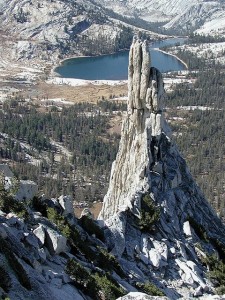This popular Class III 5.6 climb offers spectacular views from Yosemite’s high country with lots of knobs, flakes and cracks that will work on your hand jams.
Photo by Stan Shebs
Many sport climbers don’t like long approaches, but if you’re willing to make the three-mile hike to the base of Cathedral Peak in Yosemite National Park, you’ll not only experience a great climb, but the all the high-country sights and experiences that inspired John Muir himself. The peak stretches 10,940 feet from Yosemite’s Tuolumne Meadows area. It’s a classic climb that allows you to head up the south-east buttress route and experience the unique formations that will involve climbing over cracks, knobs and flakes. The first ascent up this way was done by Chuck Wilts and Spenser Austin in 1945 and it’s been a popular route ever since.
Cathedral Peak can be accessed from Highway 120 (also called Tioga Pass road), west of Yosemite Valley and East of the city of Lee Vining. The trail head to the approach hike is accessed via the Cathedral Lakes trail that starts from the Tuolumne Meadows store parking lot and heads towards Budd Lake. From there the trail leads you to the buttress of Cathedral Peak which will take about one and a half hours to reach, and measures about three miles in distance.

The route up Cathedral peak is rated a class III 5.6, and will take about five to six hours to complete. You begin with some low-angled slabs that lead to a straight-in jam crack and ends up on a ledge. The next pitch ascends to another ledge before you reach the following two pitches up over knobs and flakes to the large ledge at the base of a chimney. Climb the chimney, using a small ledge to belay on, and head on towards two more pitches up cracks and flakes. You’ll then find yourself climbing a wide crack to the top of a flake followed by a delicate step-a-cross that ends on the summit block.
To descend, you’ll have to climb down the twin cracks on the west side of the summit, which is John Muir’s original ascent route rated at a class 4-5. You’ll work down to the low point between Cathedral Peak and Eichorn Pinnacle which both offer beautiful views. Then you traverse north and across slabs to the east ridge and drop down scree and talus to the base.
The route doesn’t require any specialized equipment. Most who have climbed this route several times leave their packs in the trees at the base. The route is very popular and minimizing your impact here can do a lot to keep the area open and clean. For more information visit http://www.nps.gov/yose/index.htm
